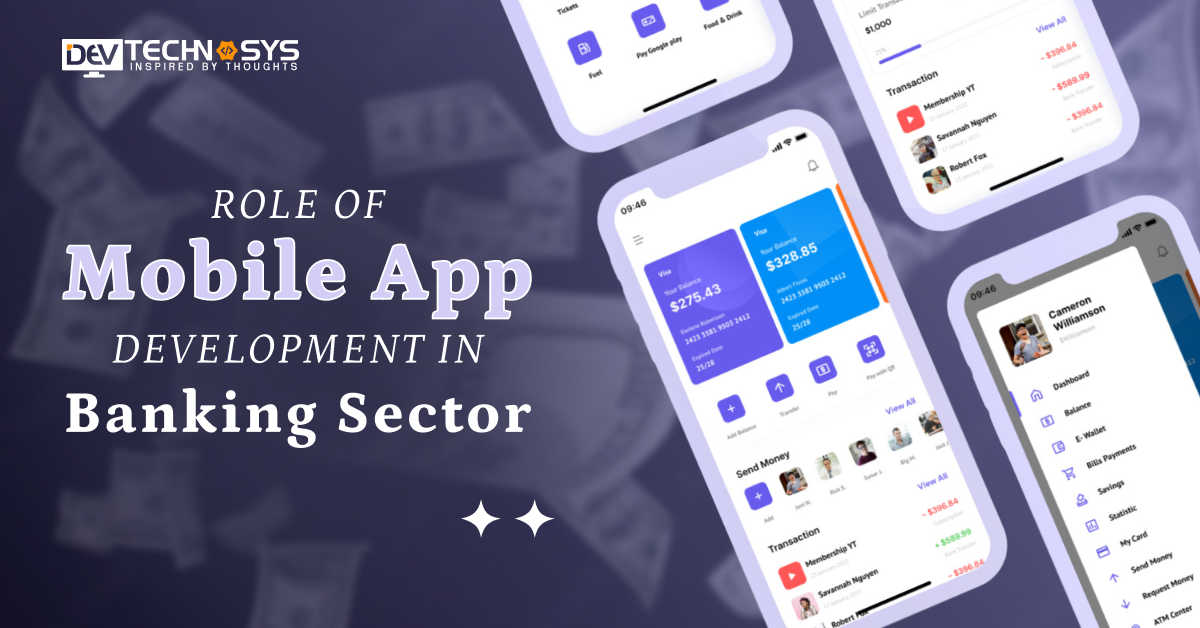It has been a long time that businesses are trying to transform the old finance and banking industry into a new one which can fulfill the modern needs and requirements of people. Additionally, it should also target their interests for enhancing money transferring experience. To accomplish this, it is quite necessary to know the role of mobile app development in banking sector in 2025.
Since the Internet got revealed multiple innovations have been made to improve the functionality of banking systems. Further, it is going to be developed more with the help of different advanced technologies like AI, Blockchain, Cybersecurity, and Cloud Computing.
To know the role of mobile app development in banking sector in 2025, we have brought up this blog for you. So that you can easily understand various topics and initiate the investing process.
What is the Role of Mobile App Development in Banking Sector in 2025?
By offering better client experiences, expanding accessibility, and enhancing security, mobile app development will continue to transform the banking industry in 2025. In order to establish a smooth and safe banking environment, mobile apps will use cutting-edge technologies like blockchain, biometrics, and artificial intelligence. The future of financial services will be greatly influenced by mobile app development as banking becomes more mobile-centric.
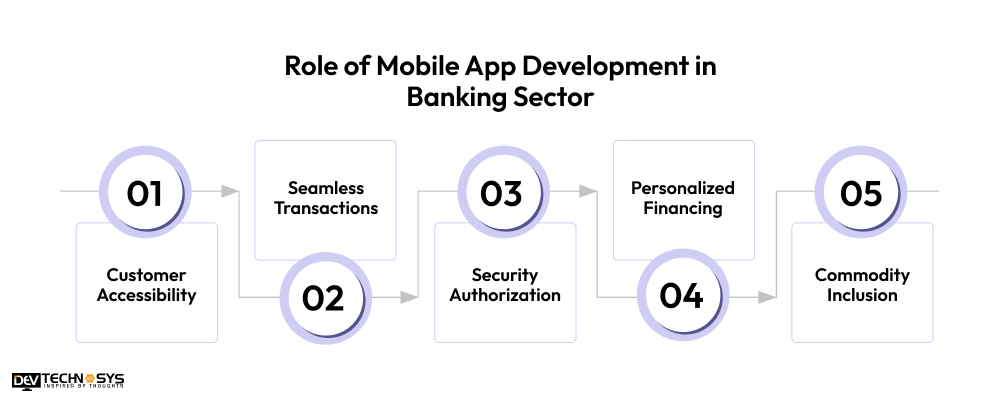
1. Customer Accessibility
Customers will have round-the-clock access to their bank accounts, transactions, and services through mobile apps, no matter where they are. Users benefit from increased convenience as a result, allowing for mobile banking.
2. Seamless Transactions
Users will find it easy to make investments, pay bills, and conduct safe, real-time transfers banking IT solutions. This simplifies financial processes and lessens the need for in-branch visits.
3. Security Authorization
Advanced security features including end-to-end encryption, multi-factor authentication, and biometric authentication will be incorporated into mobile apps. Real-time fraud prevention and user data protection are two benefits of this technology.
4. Personalized Financing
It is good to approach a mobile banking app development company to use AI and machine learning to provide specialized services like financial advising, product suggestions, and budgeting tools. This satisfies individual needs and increases client happiness.
5. Commodity Inclusion
Through smartphones, mobile apps will give underprivileged people access to basic banking services like loans and savings accounts. This encourages inclusiveness globally and democratizes financial services.
Market Stats for the Banking Sector
- The global banking market’s net interest income is expected to reach an astounding $8.94 Trillion by 2025.
- With a forecasted market volume of $7.33 Trillion in the same year, traditional banks account for the majority of the industry.
- It is projected that Net Interest Income will grow at a pace of 4.91% CAGR per year between 2025 to 2029 in the future.
- The market will grow significantly as a result, reaching a volume of $10.83 Trillion by 2029.
- It is significant to highlight that, from a global standpoint, China will produce the most Net Interest Income.
- China is predicted to produce a significant sum of $4,689 Billion in 2025.
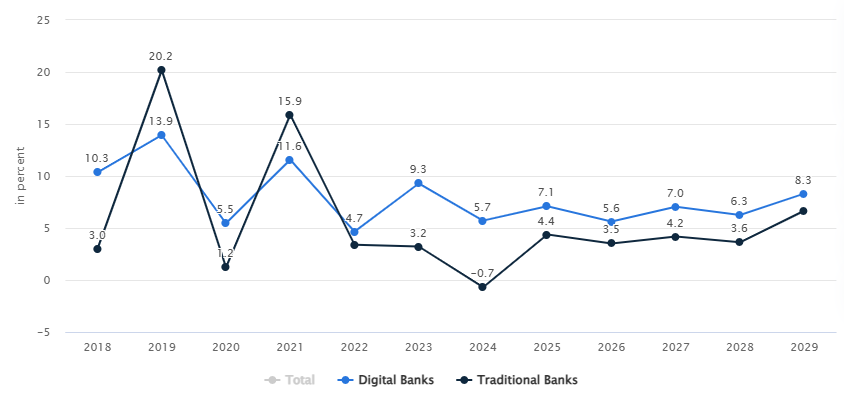
Market Trend
- At a compound annual growth rate of 11.1% CAGR from 2021 to 2026, the worldwide digital banking market is expected to reach $1.8 Trillion.
- Globally, 73% of users use digital banking services, and the most popular platform is smartphone apps.
Growth Factor
- Increasing smartphone adoption and the emergence of mobile-first consumers are major factors propelling the digital banking industry.
- 66% of people used online banking during the COVID-19 epidemic, which sped up the use of digital financial services.
Business Sustainability
- By incorporating ESG (Environmental, Social, Governance) standards into digital finance systems, financial organizations are putting a greater emphasis on sustainability.
- For long-term growth and sustainability, 50% of banks intend to greatly boost their investments in digital transformation projects.
Targeted Banking Mobile App Trends in 2025
By 2025, targeted banking mobile applications will be more inventive and individualized, providing users with specialized financial solutions. To improve user experiences, these apps will make use of cutting-edge technologies like blockchain, AI, and machine learning.

1. AI-Driven Personalization
Using AI in banking industry is a good move to examine user behavior and offer customized banking services, like product recommendations and individualized financial advice.
- Enhances the consumer experience by providing pertinent product offers.
- Uses AI insights to assist users in making wiser financial decisions.
- Increases client interaction by offering tailored suggestions.
Impact: AI will increase customer satisfaction and loyalty by fostering closer ties between banks and their clients.
2. Biometric Authentication
By 2025, biometric authentication—like fingerprint or facial recognition—will play a major role in providing safe access to mobile banking apps.
- Ensures that only authorized individuals can access accounts, improving security.
- Minimizes the possibility of identity theft and fraud.
- Offers users a smooth, password-free login experience.
Impact: Banking will become safer and more convenient with biometric authentication, which will increase consumer confidence and security.
3. Integrated Digital Wallets
In order to manage payments, loyalty programs, and cryptocurrencies on a single platform, mobile apps will increasingly include integrated digital wallets.
- Simplifies payments by permitting transactions using QR codes and contactless methods.
- Accepts a variety of payment methods and currencies at one location.
- Maximizes user benefits through integration with loyalty schemes.
Impact: Users’ transactions will be made simpler with the help of digital wallets, which will provide a centralized, practical payment experience.
4. Voice-Activated Banking
As voice assistants in banking apps evolve, users will be able to use voice requests to carry out operations like paying bills, moving money, and checking balances.
- Promotes accessibility by enabling individuals to bank hands-free.
- Accelerates transactions and inquiries, saving time.
- Improves convenience for those with limited mobility or disability.
Impact: Voice-activated banking will improve accessibility and convenience of use for a wide range of consumers.
5. Blockchain Technology for Transactions
Hiring a banking software development company is beneficial for using Blockchain. It will be used to speed and protect financial transactions, lowering the risk of fraud and promoting transparency.
- Increases the speed and transparency of transactions using decentralized ledgers.
- Prevents transaction costs by doing away with the necessity for middlemen.
- Boosts security by lowering the chance of fraud and guaranteeing data integrity.
Impact: Payment systems will be transformed by blockchain, which will enable safer and quicker financial transactions.
6. AI-Powered Chatbots
Mobile apps with AI-powered chatbots will manage standard customer care duties, respond to inquiries, and offer round-the-clock assistance.
- Optimizes customer service by offering prompt assistance and responses.
- Reduces operating expenses by automating routine operations and questions.
- Delivers individualized support according to client information and preferences.
Impact: Chatbots driven by AI will improve customer happiness and operational efficiency.
7. Digital-Only Banks
Many banks will just use mobile applications to conduct business in 2025, providing all of their services without the need for physical facilities.
- Lowers fees because there is no physical infrastructure.
- This makes it more accessible to clients using mobile devices.
- Provides a banking experience that is more simplified and effective.
Impact: The traditional banking paradigm will be redefined by digital-only banks, which will increase the accessibility and affordability of banking services.
8. Real-Time Payments and Transfers
Instantaneous, real-time money transfers between accounts, both locally and abroad, will be made possible by mobile apps.
- Enables money transactions quicker and more effectively.
- Reduces down on wait times for both clients and companies.
- Makes international payments easier and more economical.
Impact: Financial agility will be improved by real-time payments, which will help both individuals and companies.
Various Types of Banking Apps
There are many different kinds of banking apps, each created to address particular requirements in the financial industry. From straightforward money transfers to more intricate wealth management services, these applications offer consumers customized experiences.
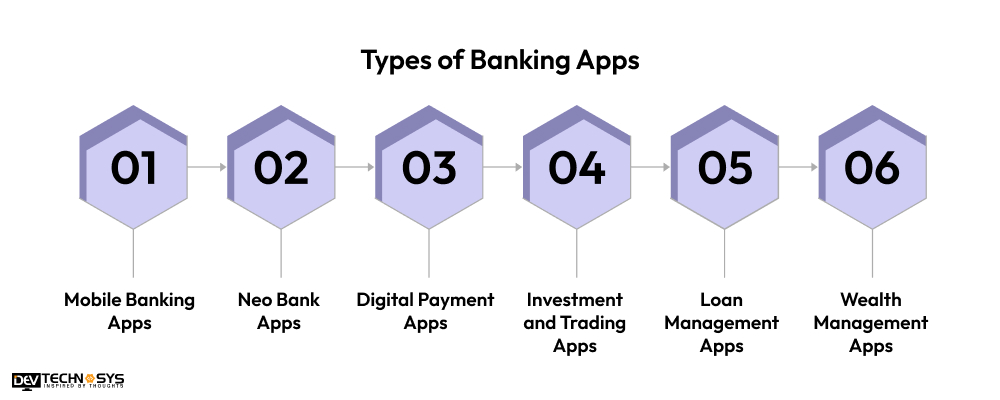
1. Mobile Banking Apps
Basic banking functions including bill payment, fund transfers, and account management are provided by mobile banking apps. They enable users to conduct daily financial activities and give them real-time access to banking information.
- Chase Mobile: Provides standard banking services like bill payment, money transfers, and account balance checks.
- Bank of America Mobile Banking: Gives users access to real-time notifications, mobile check deposits, and account management.
2. Neo Bank Apps
Neo banking applications use mobile platforms to offer comprehensive banking services without the need for physical locations. Because they don’t have any physical infrastructure, their mobile banking app development cost is quite high.
- Chime: A digital-only bank that prioritizes mobile users and offers savings, checking accounts, and no fees.
- Monzo: A digital bank with headquarters in the UK that provides a completely mobile banking experience with tools for budgeting and real-time payment alerts.
3. Digital Payment Apps
These applications concentrate on giving users the ability to swiftly send or receive money using their mobile devices. They enable consumers to pay for goods and services straight from their phones and send money to others. Apps like Apple Pay and PayPal are well-known examples.
- PayPal: Enables users to handle digital wallets, send and receive money, and pay for goods and services.
- Venmo: A well-known program for bill splitting, peer-to-peer transactions, and using linked bank accounts or cards to pay friends or businesses.
4. Investment and Trading Apps
Users can purchase stocks, manage their portfolios, and follow market developments in real time with the aid of investment applications. Businesses can invest in Android app development to offer resources for investing, research, and occasionally even robo-advisory services.
- Robinhood: Delivers commission-free trading with an intuitive interface for stocks, options, and cryptocurrency.
- E*TRADE: Includes commission-free trading for stocks, bonds, and exchange-traded funds (ETFs), research, and investment tools.
5. Loan Management Apps
These applications offer resources for managing and applying for loans, such as mortgages, auto loans, and personal loans. With the help of integrated tools, users can compute interest and check loan status. Apps for loan management make borrowing easier and guarantee consumers to handle money.
- Upstart: Uses artificial intelligence (AI) to assess creditworthiness and expedite approval for personal loans.
- SoFi: Brings mortgage products, personal loans, and refinance options for student loans, all of which can be managed using a mobile app.
6. Wealth Management Apps
Apps for wealth management are made for people who wish to gradually increase and plan their financial holdings. These apps provide financial planning, portfolio management, and investment tracking services. These applications offer users who want to accumulate wealth and make retirement plans.
- Betterment: An app that offers automated, goal-based investment and wealth management strategies is called a robo-advisor.
- Wealthfront: Gives automated advice, tax optimization, and individualized financial planning and investment management.
Major Attributes of Different Banking Apps
Numerous tools that make financial management simpler, quicker, and more secure are now available through banking apps. These apps give users a smooth and customized banking experience by integrating cutting-edge technologies.
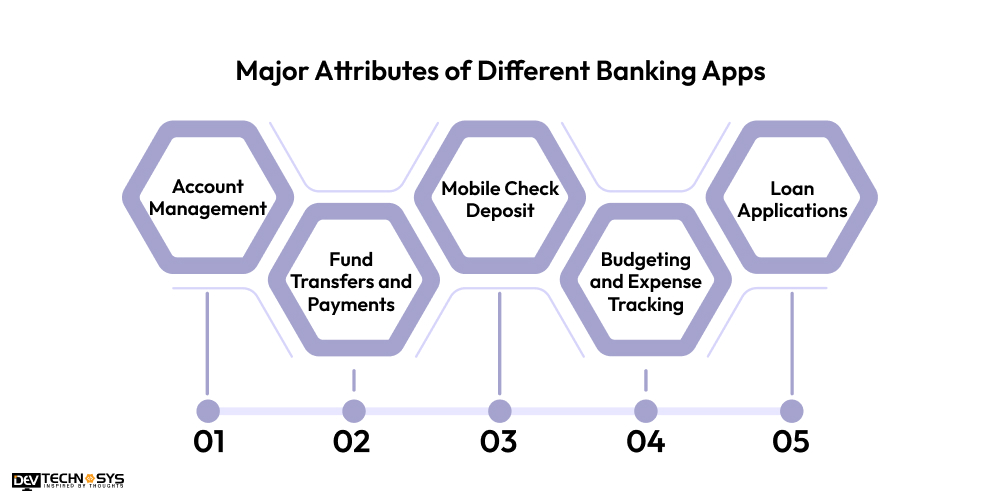
1. Account Management
Users may check their account balances, transactions, and statements in real time with banking apps. Additionally, clients can view comprehensive account histories for several accounts at once. Effective money management and financial activity tracking are made simple by this function.
2. Fund Transfers and Payments
Through mobile banking apps, users can send money to others, pay bills, and move funds across accounts. The majority of apps facilitate both domestic and international transfers, which speeds up and simplifies financial transactions. The hybrid app development can enable safe transfers and simplify daily payments.
3. Mobile Check Deposit
By only snapping a picture of the check, users of banking apps can deposit it. By processing the check for deposit electronically, the app eliminates the need to go to a bank branch. This function offers a practical method of making a remote deposit.
4. Budgeting and Expense Tracking
Users of banking apps can track spending patterns, classify expenses, and create budgets. In order to assist users you can develop budgeting and banking apps like Albert to provide insights into spending trends. This function is very helpful for managing personal finances.
5. Loan Applications
Users of banking apps can apply for loans, check the status of their loans, and pay back their mortgage or personal loans. This functionality guarantees that consumers may effortlessly manage loan payments from their smartphones and expedites the borrowing procedure.
Advantages of Banking Mobile App Development
By improving customer experience and simplifying financial services, the mobile app development role in banking offers several benefits. These applications give consumers better security, on-the-go personalized financial management, and easy access to banking.
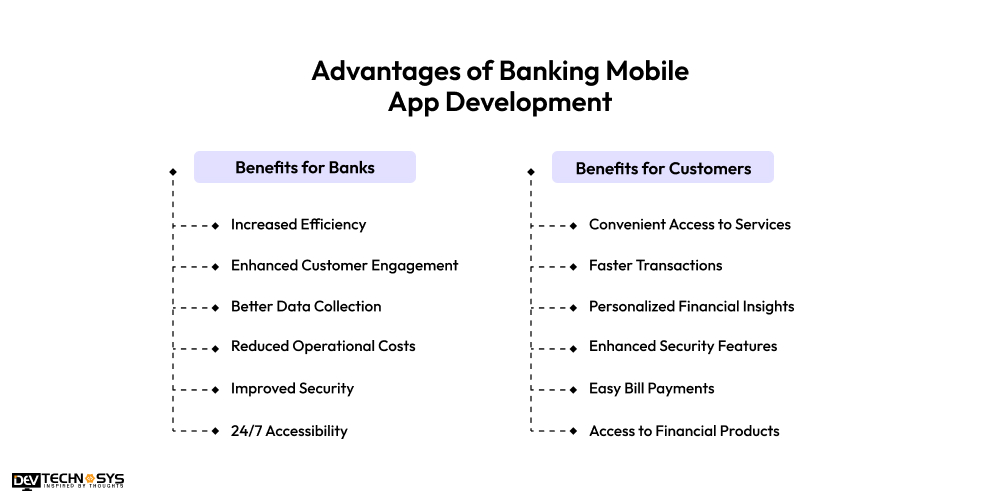
1. Benefits for Banks
-
Increased Efficiency
By decreasing human labor and increasing operational efficiency, mobile apps simplify banking operations. Faster service delivery and reduced overhead expenses result from this.
-
Enhanced Customer Engagement
To further engage customers, banks can provide real-time updates, discounts, and personalized services. Customer satisfaction and loyalty are increased as a result.
-
Better Data Collection
Banks may gather and evaluate consumer data using mobile apps, which facilitates better decision-making and more focused marketing campaigns. More specialized iPhone app development services result from this.
-
Reduced Operational Costs
Mobile apps assist banks in lowering personnel and infrastructure costs by eliminating the need for physical branches and manual procedures.
-
Improved Security
Mobile apps are more secure because of cutting-edge technologies like biometrics, encryption, and two-factor authentication, which safeguard private user information.
-
24/7 Accessibility
Businesses can contact a mobile application development company allowing banks to offer 24/7 services. These include bill payment, account management, and transfers, so that clients can use them whenever they choose.
2. Benefits for Customers
-
Convenient Access to Services
With the use of banking applications, consumers can conveniently access their accounts and conduct transactions without ever having to go to a branch.
-
Faster Transactions
Bill payments, transfers, and other financial services may be completed quickly and easily with mobile apps, which saves time and improves banking efficiency.
-
Personalized Financial Insights
Investment in mobile application development to create banking apps can help users to manage their finances. These apps provide budgeting tools, spending analytics, and personalized financial advice.
-
Enhanced Security Features
Customers enjoy safer transactions and improved personal information protection with biometric authentication, encrypted data, and fraud alerts.
-
Easy Bill Payments
Through banking apps, customers can easily track and pay their payments, avoiding late fees and eliminating the need for paper checks.
-
Access to Financial Products
Customers can apply directly for loans, credit cards, and investment products through digital banking architecture, which expedites the application process and minimizes paperwork.
Conclusion!!
Now, we have understood every information related to the role of mobile app development in banking sector in 2025. So, you should now focus on the following points to elevate your business strength.
- The future of Blockchain in banking industry are the modern systems like dApps and NFT marketplace.
- Your system can be integrated to other applications and websites.
- Unbiased market growth can be experienced through the development of banking mobile apps.
- There can be multiple revenue sources through which businesses can earn income.
With all these offerings, you can make your existing banking and money lending systems sophisticated with mobile apps in 2025.
FAQs
1. How Will Mobile Apps Impact Customer Experience in Banking by 2025?
By providing services that are customized according to customer preferences, mobile apps will deliver a smooth and customized banking experience. Faster transactions and round-the-clock access to account information will also be made possible by them. AI-powered suggestions and real-time warnings will increase user engagement even further.
2. How do Mobile Apps Streamline Banking Operations?
- By automating repetitive processes like bill payment, fund transfers, and balance inquiries, mobile apps lessen the need for human intervention.
- They improve operational efficiency by enabling real-time transaction processing.
- Apps with AI incorporated in may make tailored suggestions, enhancing financial services even further.
3. What Security Features Will Mobile Banking Apps Include in 2025?
Advanced security features like multi-factor authentication (MFA) and biometric authentication will be incorporated into mobile banking apps. Additionally, they will use end-to-end encryption to safeguard private client information. AI will be used to identify fraud trends and provide users with immediate alerts.
4. How do Mobile Apps Benefit Banking Businesses?
- By eliminating the need for physical branches and in-person services, mobile apps lower operating costs.
- They give banks access to a multitude of data that aids in creating more focused marketing campaigns and enhancing customer support.
- A larger consumer base results from improved accessibility, which raises revenue and customer retention.
5. What Role do Mobile Apps Play in the Future of Digital Payments?
- Digital wallets and contactless payments will be made possible by mobile apps, allowing for quicker and safer transactions.
- Peer-to-peer (P2P) payment systems will be integrated with them, enabling smooth money transfers.
- Cross-border payments will be supported by mobile banking apps, giving users access to a worldwide payment option.
6. How Will Mobile Banking Apps Improve Financial Inclusion in 2025?
With the use of inexpensive smartphones and mobile apps, financial services will be able to reach underprivileged communities in isolated locations. Without the need for physical branches, they will provide simple access to loans, savings, and financial planning resources. For people without access to traditional banking, these apps will fill the gap.
